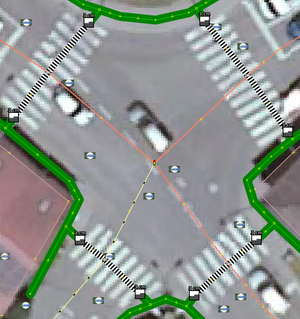Tag:footway=sidewalk
| Description |
|---|
| Sidewalks as separate ways. |
| Group: highways |
| Used on these elements |
| Requires |
|
or |
| Useful combination |
|
| See also |
| Status: approved |
| Tools for this tag |
|
Use footway=sidewalk along with highway=footway to tag ![]() sidewalks (also known as pavement/footway in the UK or a footpath in Australia) as distinct ways from the carriageway.
sidewalks (also known as pavement/footway in the UK or a footpath in Australia) as distinct ways from the carriageway.
For crosswalks use footway=crossing.
footway=sidewalk is also sometimes used with other highway=* values
- sidewalks under construction highway=construction + construction=footway
- combined footway and cycleway - highway=path + bicycle=designated + foot=designated + segregated=no.
This article describes the "separate way" approach to mapping sidewalks. Alternatively, especially if the sidewalk is just attached with a kerb, sidewalks may be mapped as properties on the motorized roads, see Sidewalks for details on this distinction.
There is currently no consensus on how to handle naming sidewalks. The name is usually not tagged anywhere. Throughout the years, there have been proposals to use street:name=*, is_sidepath:of:name=* tags (see Proposal:Key:is sidepath), associatedStreet relations, or Proposal:Relation:street. Alternatively, the sidewalk is seen as part of the street by some, and might be considered for tagging with the same name=* tags as the roadway. See also Key:footway#Association with the street for more information.
What is considered a sidewalk
Generally any walkway running parallel to the road, which provides an alternative method of travel along the road for pedestrians is considered a sidewalk. A physically barrier preventing direct access from the sidewalk to the road would not prevent the way from being considered a sidewalk.
Easy mistakes
If you move the sidewalk tagging from part of a highway to separate ways, make sure you also update the sidewalk=* (alongside any subtags thereof) of the main highway to sidewalk=separate. This causes issues with data consumers which see two sidewalks side by side and cause issues from redundancy (e.g. having the sidewalk surface mapped twice, once in sidewalk:surface=* on the highway=* and surface=* on the footway=sidewalk) to contradictory tags (e.g. foot=use_sidepath with sidewalk=(left/both/right)) to routering errors (routers generally depriotise highways with sidewalk=separate but can route pedestrians over the carriageway even with a parallel highway=footway).
Also make sure to not leave sidewalks isolated with no connection to the carriageway or other paths. Generally add crossings at intersections (preferably at official crossings) or draw some driveways if you haven't done so already.
To a lesser extend, sidewalks are compulsory in many countries so if you have any hiking routes, make sure you move them from the carriageway to the sidewalk (in fact, QA will complain that the route goes through ways tagged with foot=use_sidepath).
See Guidelines for pedestrian navigation for more not-to-dos.
How to map
See footway=* for usage instructions.
See also
- an overview about mapping Sidewalks
- footway=* - Further refinement of footways
- sidewalk=* - Indicates the presence or absence of a sidewalk (pavement/footway)
- is_sidepath=* - Denotes whether a footway is adjacent to a street.
- cycleway=sidepath - Equivalent for highway=cycleway
 associatedStreet / street
associatedStreet / street- Proposed features/Sidewalk as separate way - approved proposal that introduced this tag
- Proposed_features/sidewalk_schema
- comprehensive explanation for bicycle way tagging
- Guidelines for pedestrian navigation
| ||||||||||||||||||||||||||||||


